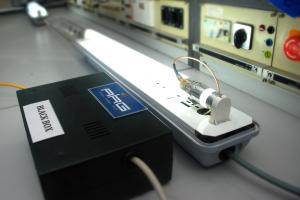New Wi-Fi antenna enhances wireless coverage

The prototype antenna consists of a fluorescent tube that connects to the router through a tuned wire coil in a sleeve slipped over one end.
The prototype antenna consists of a fluorescent tube that connects to the router through a tuned wire coil in a sleeve slipped over one end.
Wi-Fi routers are essentially two-way radios that connect digital devices to the Internet. But in many buildings, providing complete coverage is a challenge. Radio “dead spots” can occur in areas where solid walls or appliances block a router’s signal entirely, or degrade it to become so weak that a portable Wi-Fi device, such as a tablet or phone, cannot connect reliably.
When electricity flows through the argon-mercury vapour in a fluorescent tube, it forms an ionised gas or plasma. Plasma has conducting properties comparable to a common metal radio antenna.
This allows an attached router to send and receive radio signals through the light tube on the standard 2.4-gigahertz Wi-Fi frequency in exactly the same way it does through a regular antenna. The router’s radio waves can ionise the gas in the tube, so it acts as an antenna whether the light is on or off.
According to the research team, the plasma found in a standard 62-centimetre light tube is highly conductive and signal measurements on a test device show that it’s strong and stable. Thus plasma compares favourably with standard metal Wi-Fi antennas for transmitting and receiving.
The prototype antenna consists of a fluorescent tube that connects to the router through a tuned wire coil in a sleeve slipped over one end. The coil passes the router’s radio signal through the glass of the fluorescent tube and into the plasma.
The team says that multiple antennas could be connected to a single router through a building’s electrical wiring using existing Wi-Fi standards. This would create a separate antenna in every room where there is a dedicated fluorescent light fixture and provide low cost building-wide wireless Internet coverage.
Further studies by the team may include adding more fluorescent tubes in various configurations to investigate the capability and performance of multiple plasma antenna arrays. One possible application could involve installing this technology in outdoor billboard lights. Each plasma antenna array would then be integrated with a Wi-Fi router to provide large-scale, system-wide wireless communication.
For further information contact:
Dr Mohd Tarmizi Ali
Associate Professor and Head of the Centre for
Communication Engineering Studies
Faculty of Electrical Engineering
Universiti Teknologi MARA, Malaysia
E-mail: mizi732002@salam.uitm.edu.my
*This article also appears in Asia Research News 2015 (P.52).
Associated links
Read Asia Research News 2015
Download a copy of Asia Research News 2015 for free
Media Contact
More Information:
http://www.researchsea.comAll latest news from the category: Power and Electrical Engineering
This topic covers issues related to energy generation, conversion, transportation and consumption and how the industry is addressing the challenge of energy efficiency in general.
innovations-report provides in-depth and informative reports and articles on subjects ranging from wind energy, fuel cell technology, solar energy, geothermal energy, petroleum, gas, nuclear engineering, alternative energy and energy efficiency to fusion, hydrogen and superconductor technologies.
Newest articles

Silicon Carbide Innovation Alliance to drive industrial-scale semiconductor work
Known for its ability to withstand extreme environments and high voltages, silicon carbide (SiC) is a semiconducting material made up of silicon and carbon atoms arranged into crystals that is…

New SPECT/CT technique shows impressive biomarker identification
…offers increased access for prostate cancer patients. A novel SPECT/CT acquisition method can accurately detect radiopharmaceutical biodistribution in a convenient manner for prostate cancer patients, opening the door for more…

How 3D printers can give robots a soft touch
Soft skin coverings and touch sensors have emerged as a promising feature for robots that are both safer and more intuitive for human interaction, but they are expensive and difficult…





















